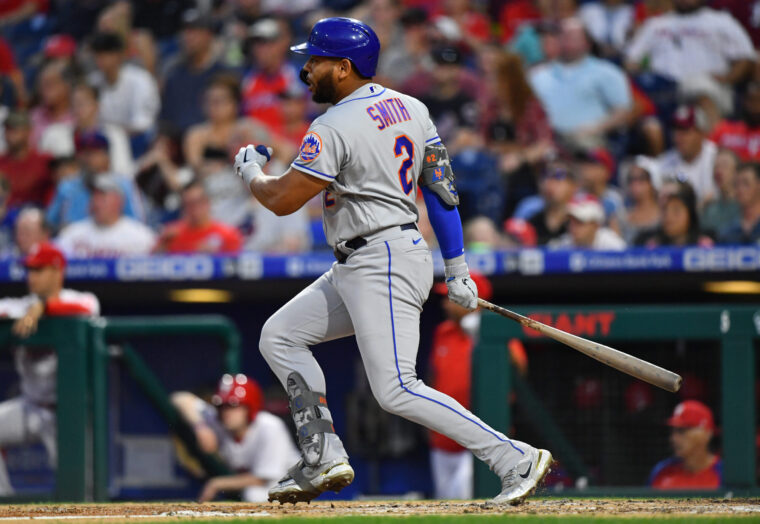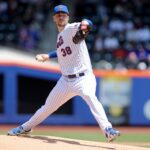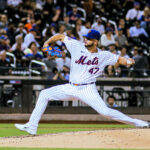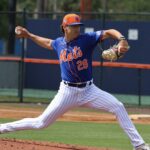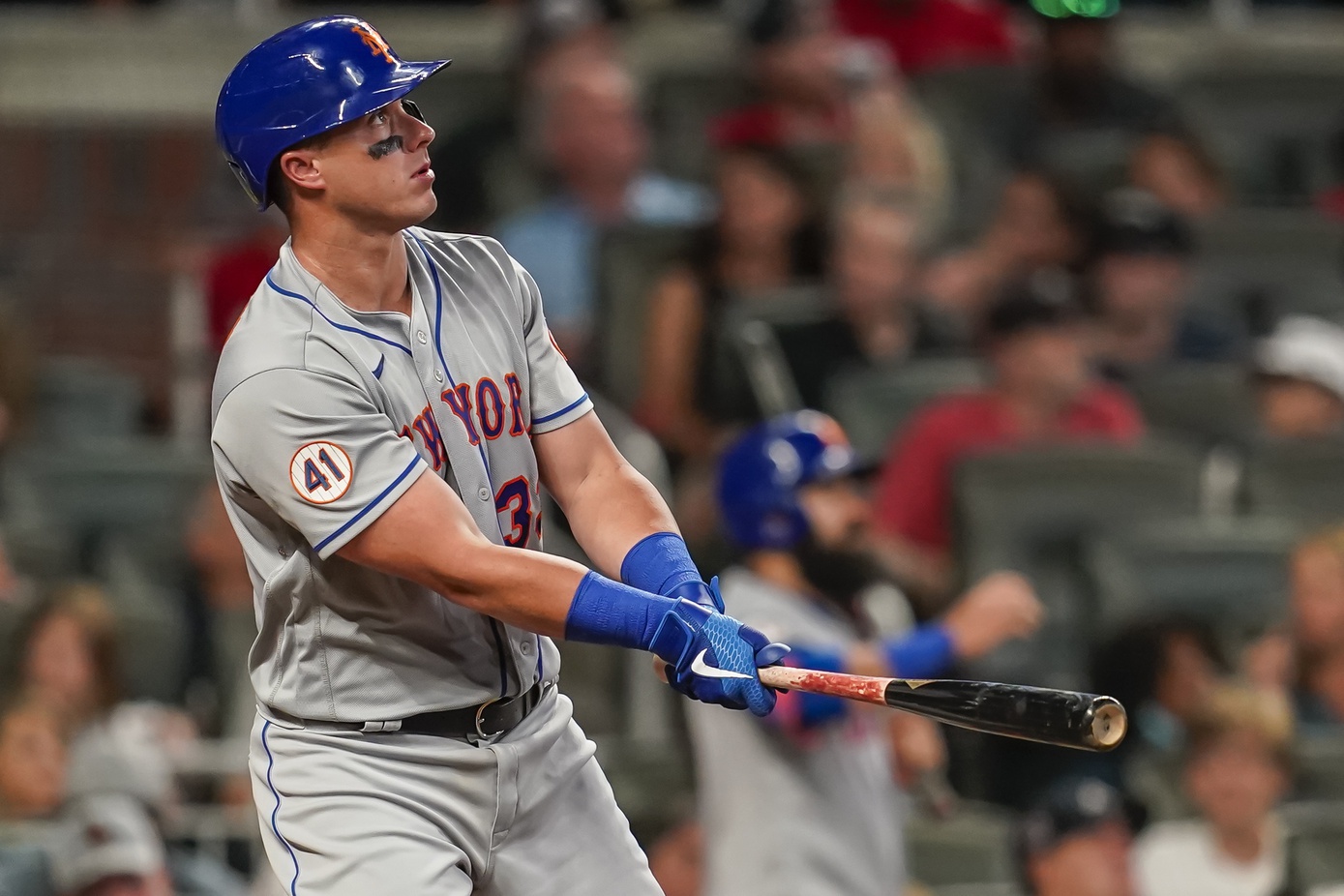
Mandatory Credit: Dale Zanine-USA TODAY Sports
The 2021 season was one that included lots of underachieving for the New York Mets. No part of the roster better describes that than the offense.
There were times when it seemed like things were starting to click, but that feeling never lasted long. The Mets started out slow as a squad, then key hitters got injured in May, and they never fully recovered to live up to lofty preseason expectations.
That ended with them posting a team wRC+ of 96, which ranked 16th in the league, while their .705 team OPS ranked 24th. There were a couple of consistent bright spots in Pete Alonso and Brandon Nimmo. However, Nimmo was healthy for only 92 games, and Alonso couldn’t do everything himself.
When looking at the Mets’ roster, there are three dudes with plenty to prove after a disappointing season: James McCann, Jeff McNeil, and Dominic Smith. Which one has the most to prove by the time Opening Day rolls around (assuming this lockout ends at some point)?
James McCann
One thing the Mets were hoping for when they signed McCann last winter was that the catching position wouldn’t be a black hole in the lineup like it was the year prior. New York backstops slashed .237/.289/.393 with an 89 wRC+ and 0.2 fWAR in 2020. While the position fWAR went up to 1.1, it was only because it was a full season instead of a 60-game schedule. The slash line dropped to .222/.279/.331, and the wRC+ went down to 71.
Four different players donned the tools of ignorance for New York in 2021, but McCann took up the majority of the playing time, and his first year in Queens didn’t go as planned. In 412 total plate appearances, he slashed .232/.294/.349 with 10 home runs and 46 RBI, which resulted in an 80 wRC+ and 0.5 fWAR. Between 2017 and 2020, McCann posted a ground-ball rate below 40% and a hard-hit rate above 35% three times. In 2021, his 51.5% ground-ball rate was the worst it’s ever been, while his 29.7% hard-hit rate hasn’t been that low since 2015 (26.6%).
It’d be unfair to expect elite offensive production from him moving forward, but one can assume the hope would be to produce at the level he had in the two years before joining the Mets. In 2019, he posted a 108 wRC+ and .789 OPS in 476 plate appearances, while 2020 included a 142 wRC+ and a .896 OPS in 111 plate appearances.
There will be pressure on him to perform, and we saw last season that he could find the bench in favor of Tomas Nido if he really hits the skids. But, in all the spending the Mets have done and likely will do, upgrading at catcher isn’t on the list, so he’s got an inside track at the majority of playing time again.

Mandatory Credit: Wendell Cruz-USA TODAY Sports
Jeff McNeil
Of these three, watching McNeil suffer through the kind of year he had in 2021 was probably the most surprising. He went through some offensive struggles of his own in 2020, but he still ended up slashing .311/.383/.454 through 209 plate appearances, which sussed out to a 131 wRC+.
For the most part, that’s been the kind of hitter McNeil has proven to be since the start of his big-league career in 2018. Until this past year, of course.
He hit just .251/.319/.360 through 426 plate appearances, which led to a 93 wRC+ and 0.5 fWAR. McNeil just couldn’t get on any kind of extended roll, either. Here are his monthly wRC+ numbers throughout the year: 83, 128, 43, 155, 50, 87. And although the left-handed hitter improved his chase rate (38.5% to 33.5%) while keeping his swing rate on strikes where it’s typically been (84.8% for career, 85.2% in ’21), his walk and strikeout rates regressed from 2020.
Quality of contact will be big for McNeil in 2022 — after posting career-best marks in soft-hit rate (11.2%) and hard-hit rate (37.8%) in 2019, they’ve gotten worse each of the past two seasons. Based on their Hot Stove activity, though, the Mets must not be overly concerned. If they were, one would think there would’ve been more of a push to bring Javier Báez back. Even with Eduardo Escobar and Robinson Canó taking up space in the infield, it’s not outrageous to think that McNeil’s pre-2021 performance gives him a little leeway to prove this past year was a blip in the radar.
Dominic Smith
While I do think McNeil’s rough year was the most surprising, Smith came in a very, very close second, mostly because it finally seemed like he found his footing in 2020. With a .316/.377/.616 line in 199 plate appearances, he was one of baseball’s best hitters during the pandemic-shortened season. His 166 wRC+ was tied with Jose Ramirez for the fifth-best mark, while his .993 OPS was tied for fifth with Ramirez and Mike Trout.
Not bad company to be in, I’d say. But, unfortunately for Dom, it felt like one step forward and three steps back after the year he just experienced.
In a career-high 493 plate appearances, he slashed an underwhelming .244/.304/.363, which led to an 86 wRC+ and -0.5 fWAR. The most telling statistic lies in the number of extra-base hits he racked up in each of the past two years. Despite getting more than double the plate appearances in 2021, Smith collected just 31 extra-base hits (20 doubles, 11 homers). He collected 32 in 2020 (21 doubles, one triple, 10 homers).
If he’s still a Met by Opening Day, Dom has the most to prove because of his difficult path to playing time. It’s easy to see how McCann and McNeil could get regular plate appearances week to week, but with a projected starting outfield of Mark Canha, Starling Marte, and Nimmo, it won’t be so easy for Smith. Even if the Universal Designated Hitter becomes official, players like Canó and J.D. Davis (if he’s still around, too) brings competition to that spot.
Smith will likely have fewer opportunities to prove himself than last year, and he’ll have to make the most of them to see the field consistently in some way.


